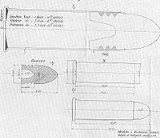
12.17 x 44 mm
Encyclopedia
The 12.17×44 mm rimfire round was developed by a joint Swedish
-Norwegian
committee in 1867. The goal was to create a round of ammunition
that would not only work in the new rifle
then under consideration (this ended up as the Remington M1867
), but also would be suitable to use in old, converted kammerlader
rifles.
The round, nominally known as 4 Linjers
(0.4 Swedish inches), had a lead bullet 12.615 mm (0.50 in) in diameter, and the caliber of the weapon was set to be 12.17 mm (0.48 inches). Early samples of the round had a 42 mm (1.65 in) long case, but soon a caselength of 44 mm (1.73 in) was decided upon.
The early rounds had a cast lead projectile weighting 5.85 kvintin (22.8 g) and 1 kvintin (3.89 g) of gunpowder
. Later rounds had a pressed lead projectile weighting 6 kvintin (23.4 g) and the gunpowder load was increased to 1.05 kvintin (4.09 g).
There was also a blank round - an ordinary cartridge case was loaded with 0.9 kvintin (3.50 g) of gunpowder, and closed with a cardboard or cork disc.
Sweden
Sweden , officially the Kingdom of Sweden , is a Nordic country on the Scandinavian Peninsula in Northern Europe. Sweden borders with Norway and Finland and is connected to Denmark by a bridge-tunnel across the Öresund....
-Norwegian
Norway
Norway , officially the Kingdom of Norway, is a Nordic unitary constitutional monarchy whose territory comprises the western portion of the Scandinavian Peninsula, Jan Mayen, and the Arctic archipelago of Svalbard and Bouvet Island. Norway has a total area of and a population of about 4.9 million...
committee in 1867. The goal was to create a round of ammunition
Ammunition
Ammunition is a generic term derived from the French language la munition which embraced all material used for war , but which in time came to refer specifically to gunpowder and artillery. The collective term for all types of ammunition is munitions...
that would not only work in the new rifle
Rifle
A rifle is a firearm designed to be fired from the shoulder, with a barrel that has a helical groove or pattern of grooves cut into the barrel walls. The raised areas of the rifling are called "lands," which make contact with the projectile , imparting spin around an axis corresponding to the...
then under consideration (this ended up as the Remington M1867
Remington M1867
The Remington rolling block M1867 was the first truly modern rifle to be adopted by the Norwegian Army. Nominally it had a caliber of 4 Norwegian decimal lines, the actual caliber was 3.88 Norwegian decimal lines , and it fired an 12.615 mm rimfire round.-Birth of the M1867:In the 1860s the...
), but also would be suitable to use in old, converted kammerlader
Kammerlader
The Kammerlader, or "chamber loader", was the first Norwegian breech loading rifle, and among the very first breech loaders adopted for use by an armed force anywhere in the world. A single shot black powder rifle, the kammerlader was operated with a crank mounted on the side of the receiver. This...
rifles.
The round, nominally known as 4 Linjers
Line (length)
The line is a unit of measurement, one line being equal to of an English inch. It was defined as one-quarter of a barleycorn, which defined the inch even before 1066. The French ligne was simarly defined as of the pouce...
(0.4 Swedish inches), had a lead bullet 12.615 mm (0.50 in) in diameter, and the caliber of the weapon was set to be 12.17 mm (0.48 inches). Early samples of the round had a 42 mm (1.65 in) long case, but soon a caselength of 44 mm (1.73 in) was decided upon.
The early rounds had a cast lead projectile weighting 5.85 kvintin (22.8 g) and 1 kvintin (3.89 g) of gunpowder
Gunpowder
Gunpowder, also known since in the late 19th century as black powder, was the first chemical explosive and the only one known until the mid 1800s. It is a mixture of sulfur, charcoal, and potassium nitrate - with the sulfur and charcoal acting as fuels, while the saltpeter works as an oxidizer...
. Later rounds had a pressed lead projectile weighting 6 kvintin (23.4 g) and the gunpowder load was increased to 1.05 kvintin (4.09 g).
There was also a blank round - an ordinary cartridge case was loaded with 0.9 kvintin (3.50 g) of gunpowder, and closed with a cardboard or cork disc.

